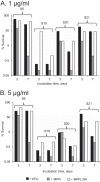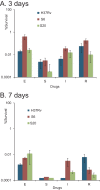Phenotypically Adapted Mycobacterium tuberculosis Populations from Sputum Are Tolerant to First-Line Drugs
- PMID: 26883695
- PMCID: PMC4808147
- DOI: 10.1128/AAC.01380-15
Phenotypically Adapted Mycobacterium tuberculosis Populations from Sputum Are Tolerant to First-Line Drugs
Abstract
Tuberculous sputum contains multipleMycobacterium tuberculosispopulations with different requirements for isolationin vitro These include cells that form colonies on solid media (plateableM. tuberculosis), cells requiring standard liquid medium for growth (nonplateableM. tuberculosis), and cells requiring supplementation of liquid medium with culture supernatant (SN) for growth (SN-dependentM. tuberculosis). Here, we describe protocols for the cryopreservation and direct assessment of antimicrobial tolerance of theseM. tuberculosispopulations within sputum. Our results show that first-line drugs achieved only modest bactericidal effects on all three populations over 7 days (1 to 2.5 log10reductions), and SN-dependentM. tuberculosiswas more tolerant to streptomycin and isoniazid than the plateable and nonplateableM. tuberculosisstrains. Susceptibility of plateableM. tuberculosisto bactericidal drugs was significantly increased after passagein vitro; thus, tolerance observed in the sputum samples from the population groups was likely associated with mycobacterial adaptation to the host environment at some time prior to expectoration. Our findings support the use of a simpleex vivosystem for testing drug efficacies against mycobacteria that have phenotypically adapted during tuberculosis infection.
Copyright © 2016 Turapov et al.
Figures







Similar articles
-
[Repeating of sensitivity tests with tuberculosis bacteria].Prax Pneumol. 1971 Apr;25(4):205-11. Prax Pneumol. 1971. PMID: 4995325 German. No abstract available.
-
Rapid phenotypic assay of antimycobacterial susceptibility pattern by direct mycobacteria growth indicator tube and phage amplified biological assay compared to BACTEC 460 TB.Tuberculosis (Edinb). 2007 Mar;87(2):102-8. doi: 10.1016/j.tube.2006.05.002. Epub 2006 Oct 10. Tuberculosis (Edinb). 2007. PMID: 17035089
-
Direct detection of rifampin- and isoniazid-resistant Mycobacterium tuberculosis in auramine-rhodamine-positive sputum specimens by real-time PCR.J Clin Microbiol. 2004 Apr;42(4):1585-9. doi: 10.1128/JCM.42.4.1585-1589.2004. J Clin Microbiol. 2004. PMID: 15071008 Free PMC article.
-
Prevalence of initial drug resistance to M. tuberculosis in new sputum positive RNTCP patients.J Commun Dis. 2003 Jun;35(2):82-9. J Commun Dis. 2003. PMID: 15562953
-
Isoniazid resistance in Rifampicin sensitive pulmonary tuberculosis in children and adolescents.Indian J Tuberc. 2024;71 Suppl 1:S145-S148. doi: 10.1016/j.ijtb.2024.05.002. Epub 2024 May 9. Indian J Tuberc. 2024. PMID: 39067947 Review.
Cited by
-
Nitric oxide induces the distinct invisibility phenotype of Mycobacterium tuberculosis.Commun Biol. 2024 Sep 28;7(1):1206. doi: 10.1038/s42003-024-06912-0. Commun Biol. 2024. PMID: 39342050 Free PMC article.
-
Characterization of Differentially Detectable Mycobacterium tuberculosis in the Sputum of Subjects with Drug-Sensitive or Drug-Resistant Tuberculosis before and after Two Months of Therapy.Antimicrob Agents Chemother. 2021 Jul 16;65(8):e0060821. doi: 10.1128/AAC.00608-21. Epub 2021 Jul 16. Antimicrob Agents Chemother. 2021. PMID: 34060896 Free PMC article.
-
Understanding the contribution of metabolism to Mycobacterium tuberculosis drug tolerance.Front Cell Infect Microbiol. 2022 Aug 22;12:958555. doi: 10.3389/fcimb.2022.958555. eCollection 2022. Front Cell Infect Microbiol. 2022. PMID: 36072222 Free PMC article. Review.
-
Risk of relapse: TB treatment outcome associates with differentially culturable M. tuberculosis counts in sputum samples.IJTLD Open. 2025 Aug 13;2(8):493-496. doi: 10.5588/ijtldopen.25.0085. eCollection 2025 Aug. IJTLD Open. 2025. PMID: 40821682 Free PMC article. No abstract available.
-
Detection of differentially culturable tubercle bacteria in sputum from drug-resistant tuberculosis patients.Front Cell Infect Microbiol. 2022 Sep 9;12:949370. doi: 10.3389/fcimb.2022.949370. eCollection 2022. Front Cell Infect Microbiol. 2022. PMID: 36159642 Free PMC article.
References
-
- Garton NJ, Waddell SJ, Sherratt AL, Lee SM, Smith RJ, Senner C, Hinds J, Rajakumar K, Adegbola RA, Besra GS, Butcher PD, Barer MR. 2008. Cytological and transcript analyses reveal fat and lazy persister-like bacilli in tuberculous sputum. PLoS Med 5:e75. doi:10.1371/journal.pmed.0050075. - DOI - PMC - PubMed
Publication types
MeSH terms
Substances
Grants and funding
LinkOut - more resources
Full Text Sources
Other Literature Sources

